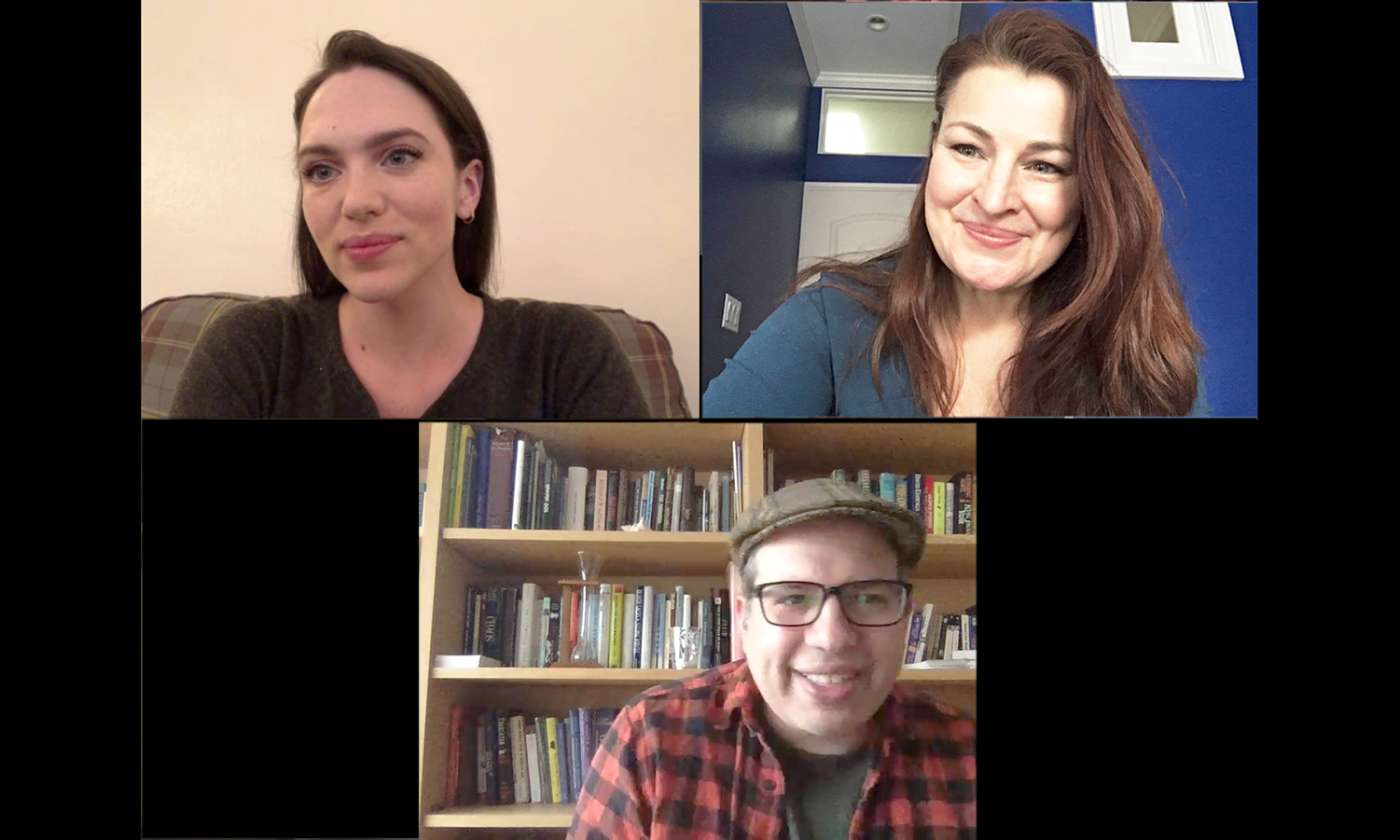Watching in my apartment in New York, it felt bittersweet. An echo of the memory of seeing him live so very recently. I remembered the sold out Gorki Theater, where there had been the familiar energy of communal participation in the audience around me. Now at home, I wondered: What am I going to do without theatre?
It was then that I had the idea of Performance for One online.
Performance for One was an existing experiment of mine, which I had done in tiny venues across New York City—in bookstores, in art galleries, in a house on Governors Island, even just on a street corner—in the fall of 2019. Each one-on-one performance was under ten minutes, though there was a Part 2, also under ten minutes, which was occasionally performed. There were seven different performers working in rotation—only one or two actors were present at a time. I was also present, to greet people and explain the program, and often there was an intern with us to help sign the audience members in. Sometimes people arrived by appointment, but other audience members just happened to walk by. Often suspicious, the passing strangers would ask us what exactly was going on, but those who ventured to try the experience usually found it a happy surprise. Most times, the performer and the audience member held hands. It was a very intimate and personal.
Online, it would be different. I would have to rewrite the plays, especially Part 1, which depended particularly on the availability of touch.
The play itself is based on a couple of my memories about my parents, one who has passed away and one who is ailing, but even more so it is about the interaction between an audience member, the performer, and me, the author. (As the author, I was deliberately both present and not present—there to greet and say goodbye, but not part of the intimate one-on-one experience.) The play is about what happens to a remembered experience when it is filtered through a performer and filtered again through the mind and experience of an audience member. It is about connection—enforced by physical touch between the audience member and performer—and how that also informs the perception of the author’s original memory.
Online, it would be different. I would have to rewrite the plays, especially Part 1, which depended particularly on the availability of touch. And instead of having that physical intimacy, the play would in part be about the longing for that intimacy. Mixed in with my memories would be the memory of touching a stranger.
One essential element of the original play would be kept: The audience member would be present—not physically, of course, but live and in the moment. The performer would see the audience member, and when the audience member reacted—smiled or got teary, giving their full attention or failing to do so—the performer would feel that reaction immediately. It would change and fuel the performance.
To create the online version, I worked with Yvonne Roen, with whom I had originally developed Performance for One. We were quickly able to put something together to beta test the idea, using my wife as a guinea pig audience member. Soon, Yvonne and I were up and running, and to my surprise all the timeslots quickly filled up. We added more, and those filled up too. So I brought on another performer, Elizabeth Chappel (who had also done the earlier version), and we settled into a three-day-a-week schedule, two to three hours each day. People seemed hungry for live theatre.
The mechanics of it are that I make the call, via Skype, create the connection with the audience member, then conference the performer in. I hang up and leave the two of them there, for their one-on-one encounter. If the audience member wants to see Part 2 (most do, in the virtual version), I see the audience member briefly again, for an intermission of sorts. But I have never witnessed the audience member witnessing the performance. Which, I must say, is hard for me.
Of course, my interactions are a performance too. I am present as the writer/director even when I am absent, and that relationship, which the performance explicitly discusses, is enforced by my early interaction with the audience member. It is often just vaguely awkward small talk, but I want it to linger as a remnant during the performance itself. As in the live version, I want to be present but not present, reflecting the implied presence all authors have in their work.
How does one find the communal experience that live theatre brings? Perhaps that is simply not possible, not yet at least.
What I didn’t expect was how energizing those little interactions would be. They are very personal, as online can be. People are in their bedrooms or out on their back porch, in pajamas or an old t-shirt. We share a little about the common experience of being in quarantine, chatting about the state of the lockdown or the experience of being confined to our homes. Sometimes we talk about theatre. The early audience members were all devoted theatregoers longing for their weekly fix. They were usually older, often in their seventies, truly confined by their possible vulnerability to COVID-19. Some were New Yorkers, but many were former New Yorkers across the States who missed the energy of New York. Soon we also had a number of audience members from England and Canada, theatregoers from different communities longing for their moment of connection.
After a few weeks, younger audience members began to reserve timeslots, looking for interactive theatre, as did people who were themselves experimenting with new forms of interaction, online and otherwise. They are an international crowd. Performance for One has been listed alongside other online experiences on a website called No Proscenium and another, with a largely Chinese audience, called NeXT Scene. I have looked into living rooms in China, Taiwan, Hong Kong, Chile, Israel, and the Czech Republic. The reach is confined only by the strength of an internet connection. On the listings of those websites, a whole world of performance is available, by phone or text or internet. Some of the pieces are explicitly theatre, others are closer to games. My experiment is stodgy by comparison, a few monologues with minor interaction, a call to an art form that used to exist in physical space. When there was physical space.
Meanwhile, I too have watched. I have watched recordings of shows I have longed to see, finally released to the public for this brief window of time. I have watched livestreams via Zoom, Instagram, Facebook, and here on HowlRound. I have looked in on Twitch. I have accumulated a list of experiences from my audience members, and my plan for the next month is to try a number of them, many of which are happening over the phone.




Comments
The article is just the start of the conversation—we want to know what you think about this subject, too! HowlRound is a space for knowledge-sharing, and we welcome spirited, thoughtful, and on-topic dialogue. Find our full comments policy here